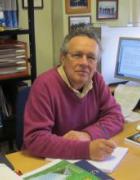

Fernando Pina
Full Professor
in
Department of Chemistry, FCT-UNL
LAQV-REQUIMTE - Associate Laboratory for Green Chemistry
office 428, tel. +351212948300, ext. 10925
email: fp@fct.unl.pt
short CV / research interests:
Fernando Pina has a degree in Chemical Engineering and a pH.D. in Photochemistry. He got the Gulbenkian Prize of Sciences 1998, Prize “Estímulo à Excelência” from the Portuguese Science and Technology Foundation, 2004 and Prize Fereira da Silva, from the Portuguese Chemical Society, 2010. He was Visiting Professor “Professore a contratto per il dottorato di ricerca in scienze chimiche" dell'Università di Firenze. 2º semestre 2000; Visiting Researcher, Massachusetts Institute of Technology, Cambridge, USA, from 5 Março-26 Agosto 2007; Visiting Professor, Munster, Germany, 1-30, Abril 2008; Visiting Professor, Bordeaux, France, December 2010.
One of his main achievements was to clarify the rationale of the photochromism observed in flavylium derivatives; Photochromism of the synthetic 4',7-dihydroxyflavylium chloride", J. Am. Chem. Soc. 1994 , 116 , 1249-1254. This was the beginning of a scientific journey that introduced in the scientific community flavylium derivatives as a new photochromic family. The work of almost two decades of research on this subject was recently summarized in the paper, F. Pina, M. J. Melo, C. A. T. Laia, A. J. Parola, J. C. Lima, “ Chemistry and Applications of Flavylium Compounds: a Handful of Colours” Chem. Soc. Rev. , 2012 , 41 , 869–908.
He and his group have shown that the flavylium based photochromic systems can operate in micelles, gels, zeolites, polymers and ionic liquids (F. Pina, J. C. Lima. A. J. Parola, C. A. M. Afonso, “Thermal and Photochemical Properties of 4’,7-dihydroxyflavylium in Water-Ionic Liquids Biphasic Systems: A Write-Read-Erase Molecular Switching System, Angew. Chem. Int. Ed. 2004, 43, 1525-1527).
In collaboration with A. Bianchi and E. Garcia-España he developed chemical sensors based on polyamine receptors. They were the first to study these systems in water superimposing the potentiometric titrations with the luminescence, absorption as well as NMR data (1998). This procedure allowed the identification of the protonation sequence of the nitrogens of the polyamine receptors, in the absence or in the presence of metal ions. A recent review on this subject was the most downloaded of the respective journal since 2005 (A. Bianchi, E. Delgado-Pinar. E. Garcia-España, C. Giorgi, F. Pina, “Highlights of metal ion-based photochemical switches”, Coord. Chem. Rev. 2014, 260, 156-215.)
Between 2011 and 2013 he was responsible for circa 1 000 000 euros of financement between National and a European project (SACS – portuguese coordinator).
5 selected publications:
Full publications list: http://www.researcherid.com/rid/C-8161-2011
1- A. Branco, L. Branco, F. Pina, “Electrochromic and Magnetic ionic liquids”, Chem. Commun. 2011, 47, 2300-2302.
2- F. Pina, J. C. Lima. A. J. Parola, C. A. M. Afonso, “Thermal and Photochemical Properties of 4’,7-dihydroxyflavylium in Water-Ionic Liquids Biphasic Systems: A Write-Read-Erase Molecular Switching System, Angew. Chem. Int. Ed. 2004, 43, 1525-1527.
3- F. Pina, M. J. Melo, M. Maestri, R. Ballardini, V. Balzani, "Photochromism of 4'-methoxyflavylium perchorate. A " write-lock-read-unlock-erase" molecular switching device", J. Am. Chem. Soc. 1997, 119, 5556-5561.
4- F. Pina, M. J. Melo, M. Maestri, P. Passaniti, V. Balzani, "Artificial Chemical systems capable of mimicking some elementary properties of neurons”, J. Am. Chem. Soc. 2000, 122, 4496-4498.
5- A. Roque, C. Lodeiro, F. Pina, M. Maestri, S. Dumas, P. Passaniti, V. Balzani “Multistate/multifunctional systems. A thermodynamic, kinetic and Photochemical Investigation on the 4’-Dimethylaminoflavylium Compound”, J. Am. Chem. Soc. 2003, 125, 987-994.